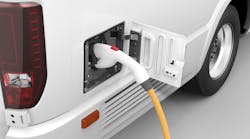We learned a lot of things while putting together our most recent Guidance Report, Amping Up: Charging Infrastructure for Electric Trucks. For example, while there is no one-size-fits-all approach there are some common steps and considerations that any fleet thinking about deploying electric trucks should follow in order to ensure they get an effective charging strategy in place.
We also know that charging will roll out in stages. The first place we will see it is at fleet depots and then perhaps we will even see fleet share charging where a truck goes from using the charger at its home depot to using the charger at some other fleet’s home depot.
The unpredictability of the hub and spoke nature of trucking means that fleets that are adding battery electric trucks will have to have chargers at their home base or warehouses or distribution centers. This approach gives fleets full control over site access, charger type, placement and timing.
However, this may not be enough for trucks with larger battery packs that will need more time to charge and/or for trucks operating longer or more unpredictable routes. While we believe that we will eventually see remote public charging emerge in high density freight corridors where distances demand a mid-trip recharge, we are not sure when this will occur.
One solution for fleets with dedicated regional routes might be to install charging stations at the depot and at customer locations.
And of course there will be what we are calling opportunity charging, which is charging at one of the developing networks of public charging stations.
But when it comes to charging for commercial battery electric vehicles we are having one of those chicken and egg discussions. Fleets are concerned about buying electric vehicles because they are not sure how they will be able to charge them and folks who might consider investing in charging infrastructure are concerned that there are not enough trucks to make their investments pay off.
What’s the answer? I do not know with 100% certainty, but I do know that in the past the market has found a way to work these issues out. Electric trucks and charging are not the first time a technology was ready before the infrastructure to support it was put in place but somehow, in the end, the market worked the problem out. Remember, there were no gas stations when Henry Ford started building automobiles.
I think both the “chicken” and the “egg” need to continue on their development curves. Fleets need to continue to order and test CBEVs and purveyors of charging stations need to take the leap of faith and start deploying a network of charging stations initially in corridors that are know for heavy truck traffic and eventually across the country.
One thing I know for sure is that one side can’t wait for the other to go all in. We need parallel developments so it won’t matter which came first.




